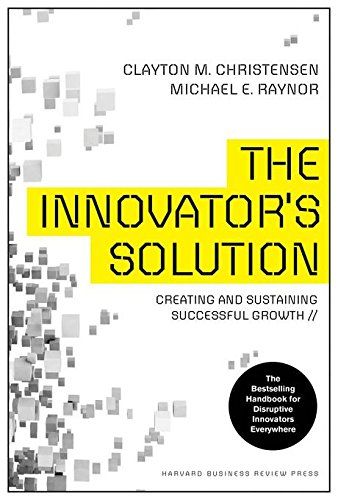The Innovator’s Solution – Clayton M. Christensen and Michael E. Raynor

“The Innovator’s Solution” was first published in 2003 and is a sequel to Christensen’s earlier work, “The Innovator’s Dilemma”. In “The Innovator’s Solution,” the authors focus on how successful companies can sustain their competitive advantage and continue to innovate over time.
Disruptive Innovation vs. Sustaining Innovation
Disruptive innovations create new markets by addressing previously unserved or underserved customer needs, while sustaining innovations improve existing products or services. Successful companies need to balance investments in both types of innovation to sustain growth over time.
Resource Dependence Can Inhibit Innovation
Companies that are heavily reliant on existing resources and capabilities may be hesitant to invest in disruptive innovation that could cannibalize their existing products or services. To overcome this, companies may need to create separate business units with a different resource allocation and incentive structures.
Innovation Requires a Culture of Experimentation
To foster innovation, companies need to create a culture that encourages experimentation, risk-taking, and learning from failure. This includes providing employees with the time, resources, and autonomy to pursue new ideas.
Innovation is a Team Sport
Innovation requires collaboration across departments and disciplines, as well as partnerships with external organizations. Successful innovators bring diverse perspectives and skill sets to create truly disruptive solutions.
The Importance of Iteration and Experimentation
Innovation is not a one-time event, but a continuous process of iteration and experimentation. Successful companies encourage experimentation and learn from both successes and failures to refine their approach to innovation.
Focus on the Job to Be Done
Instead of just focusing on customer demographics or preferences, companies should focus on the job that customers are trying to accomplish. By understanding the job to be done, companies can create products and services that better meet customer needs.
Balancing Customer Feedback with Strategic Vision
While customer feedback is important, it can also be limiting. Companies need to balance customer input with a strategic vision for where the market is heading and what solutions will be needed in the future.
Innovators Need to Be Willing to Cannibalize Their Own Products
Successful innovators are willing to cannibalize their own products and services in order to create new and better solutions for customers. This requires a willingness to take risks and make short-term sacrifices for long-term gain.
Target Non-Consumption
One way to identify opportunities for disruptive innovation is to target non-consumption, where customers are not currently using any solution to address a particular need. By creating a simple and affordable solution, companies can attract these customers and create new markets.
Small Markets Are the Starting Point for Disruption
Disruptive innovations often start in small, niche markets where customer needs are not being fully met by existing solutions. Over time, these solutions can improve and expand to eventually disrupt larger, established markets.

